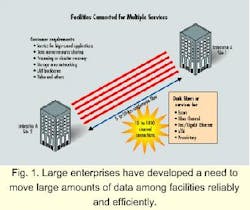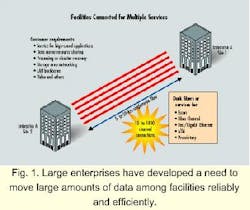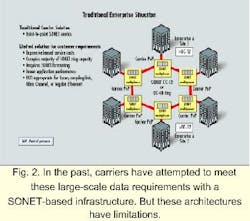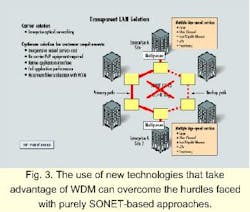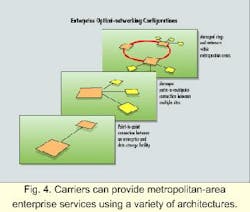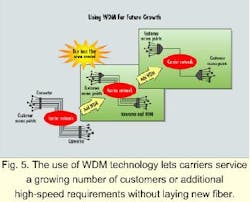Optical-networking platforms for metropolitan enterprise services
Given the demands placed upon them by today's WDM networks, optical amplifiers can no longer be merely passive gain blocks.
Enterprises need superior network performance, increased bandwidth, and additional capacity to run their day-to-day business applications effectively and maintain competitive advantages in their markets. At the same time, networks that were once thought to provide ultimate scalability have long since run out of capacity. Data traffic will greatly exceed voice traffic in volume, as Internet protocol communications have proliferated to near ubiquity. Video applications are becoming more prevalent as well. The networking transport and access infra structures of metropolitan carriers are stressed to the point of buckling under the weight of heightened, heterogeneous demands on the available bandwidth, and that trend is only going to intensify.
In the early 1990s, large banking and financial institutions in metropolitan cities were the first to seek a solution for high bandwidth in the metropolitan area: leased dark fiber. In 1996, wavelength-division multiplexing (WDM) and dense WDM (DWDM) products were introduced to provide improved bandwidth performance over private dark fiber. These high-performance private networks have been a significant commitment in time and resources from the information-technology (IT) departments of enterprises, but they have moved forward because there has been no other reasonable alternative for high-speed metropolitan services.
Several local-exchange carriers (LECs) have recently identified this need as a significant opportunity for new revenues and a new type of service that will attract new customers. These carriers are now offering "leased wavelengths" using a protocol-transparent optical-networking platform that uses the installed fiber base and provides capacity growth using WDM and DWDM. Such optical-networking solutions, when designed specifically for transport across metropolitan areas, optimize the performance of existing fiber-optic infrastructures and economically deliver a full, varied range of support for mission-critical data applications.
Among the major networking issues facing corporations today are establishing and enabling the growth of systems for disaster recovery, storing data, clustering high-speed computers for parallel processing, handling the facility moves associated with mergers and acquisitions, and implementing multimedia business tools. One way to address these issues is to connect facilities in a seamless metropolitan network that cost-effectively supports the required high-speed data protocols such as enterprise systems connectivity (Escon), coupling link, Fibre Channel, and Gigabit Ethernet. For disaster-recovery applications, the enterprise may require as much as 20 Gbits/sec of dedicated bandwidth (see Fig. 1).Enterprises today require higher-speed, transparent local area network (LAN) services. To address this need, carriers have begun to implement robust, reliable, scalable optical-networking platforms that are designed specifically for transport across metropolitan-wide enterprises. This solution allows the carrier to lease protocol-transparent wavelength services that support any high-speed data application (see Fig. 3).
Industry observers have noted this trend. The real push for high-speed, transparent LAN services is originating with the metropolitan enterprises, according to Virginia Brooks, vice president of networking and telecommunications at the Aberdeen Group (Boston). According to Brooks, these enterprises are willing to pay for the high-bandwidth connectivity required to run these applications as long as it is provided at a price-to-bandwidth ratio that is worthwhile. Until the emergence of cost-effective optical-networking solutions, the options available to enterprises had not been compelling, she concludes.
Carriers have long recognized the ability of WDM to multiply fiber capacity and create "virtual channels." Incoming application traffic is converted to specific wavelengths and multiplexed. Multiple channels are transmitted over the same optical-fiber strands. There is no performance degradation or specific protocol requirements because lightwaves of different lengths will not interfere with one another during transmission and are converted back to their original formats at output. The fiber's base bandwidth is multiplied, and if the WDM transport system is designed appropriately, each wavelength can support any protocol.
When the tremendous increase in Internet traffic and the worldwide liberalization of the telecommunications market exhausted fiber infrastructures in 1995, WDM began to be deployed extensively in long-haul SONET networks to alleviate the situation. Today, carriers are focusing on WDM and DWDM to address the explosion of voice, data, and Internet services required by their enterprise customers in metropolitan areas.Optical networking can deliver these benefits-and at a price-point that moves them out of the realm of luxury and into one of requirements that are economically justifiable. There are ad ditional benefits for the corporate customer:
- Enterprises take advantage of full application performance. Across distances up to 50 km, enterprises can simultaneously use ATM, coupling link, Escon, Ethernet, Fast Ethernet, Fiber Distributed Data Interface (FDDI), Fibre Channel, Ficon, Gigabit Ethernet, SONET, Symmetric Remote Data Facility (SRDF), Sysplex Timer, or other high-speed proprietary applications without impacting network performance. The applications can be deployed in multiple network configurations-point-to-point connections between enterprises and their data-storage facilities, managed point-to-multipoint connections among multiple sites, and managed rings and networks within metropolitan areas (see Fig. 4).
- Enterprises can lease the services at a low cost. Because of the affordability of the networking solutions underlying them, carriers can offer Escon services that are less expensive than standard T3 (44.736-Mbit/sec) services, as well as Gigabit Ethernet, Fibre Channel, and other new transparent "wavelength" services at nearly the same price.
- The responsibilities for implementation and maintenance of the system and the inherent cost and complexity lie with the carrier, not the enterprise. Enterprises spend less time and money training and deploying network support personnel and can therefore concentrate on their core businesses. Networking becomes almost invisible to the enterprise-an integrated, powerful tool that quietly enables employees to work more creatively and productively but requires little attention itself. Furthermore, concerns over equipment depreciation are eliminated.
The primary benefit for carriers is the opportunity to realize new revenues by cost-effectively introducing high-speed, protocol-transparent data-service offerings to an enterprise market that is highly anticipating them. The emergence of cost-effective optical-networking solutions developed by vendors experienced with the issues facing enterprise network managers stands to create a new, fertile market for both large incumbent carriers and smaller, more narrowly focused service providers. A host of other benefits makes optical-networking service delivery an enticing prospect for carriers:
- Carriers expand their markets by aggressively pricing leased services. The affordability of the networking solutions that enable these services positions carriers to target market segments they could not previously support cost-effectively. Because the cost to implement is low, carriers are pricing the services aggressively; because the cost for the enterprises is low, demand is significantly increasing.
- Carriers introduce new services rapidly and simply. System upgrades can be performed efficiently and easily without network downtime with the new breed of optical-networking solutions designed for metropolitan-enterprise transport. Additional channels can be added even while data is traversing existing links, which is of particular importance to corporations running mission-critical applications. Also, because service upgrades are performed remotely via software adjustments, carriers are not required to expend resources to physically replace modules or configure data-rate changes, which contributes to the low overall cost of ownership of optical-networking solutions for metropolitan-area transport.
- Carriers manage and provision services from a single platform. By reducing the number of transport systems and technologies, capital and operating expenses are kept under control. Also, the optical-networking platforms emerging today are equipped with protocol-transparent application modules. The use of modules extends a level of flexibility that is critically important to service providers, which must be adaptable to the fluctuating demands of its corporate-customer base, especially in this era when enterprises have no shortage of potential carriers vying for their business.
- Carriers maximize their investment in dark fiber and position for growth with WDM and DWDM. The competitive LEC and regional Bell operating company network planners have made significant investments to install dark fiber in metropolitan areas. In many cases, the first priority is to offer new services as quickly as possible while maximizing the return on the existing fiber infrastructure. With a platform designed specifically for enterprise transport, carriers can immediately support a host of mission-critical data-center applications such as live backup, resource sharing, and disaster recovery and use WDM and DWDM as a means of aggregating future traffic and supporting growth (see Fig. 5). The carriers' initial investment in DWDM is then minimized, and the return on investment for the services is maximized.
Decision-makers at financial institutions are weighing the value of sophisticated systems for disaster recovery against the risk of losing millions of dollars in revenue because of an outage in a data center that could suspend trading for hours. In corporate environments, decision-makers are weighing the value of a high-performance system for shared processing against the expense and complexity of replicating network servers and databases in multiple research facilities. Decision-makers for municipal governments are weighing the value of instant, wholesale data backups against the expense of producing tape backups and regularly shipping them to remote facilities.
These are the cost-of-business questions enterprises are already considering, and a consensus is gaining strength as more and more carriers introduce affordable leased WDM and DWDM service offerings for corporate customers.But while a new market is waiting for carriers, it won't wait for long, according to Aberdeen's Brooks. The carriers that act quickly to address this demand will position themselves at the forefront of a burgeoning market, she feels, while those who don't will soon find themselves playing catch-up.
The bottom line: With optical-networking solutions designed from the ground up for metropolitan-enterprise transport, carriers are realizing full return on their investments in less than one year. The technology is here. The market has arrived. Enterprise optical networking will flourish, as will the service providers who act now to deliver it. u
Brian P. McCann is president of ADVA Optical Networking Inc. (Ramsey, NJ).
